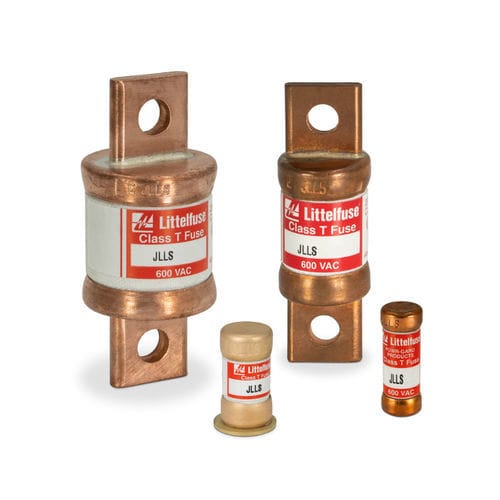
Compact fuse JLLS seriesfast-actingClass Tfor electric motors



Add to favorites
Compare this product
Characteristics
- Configuration
- compact
- Type
- fast-acting
- Class
- Class T
- Applications
- for electric motors
- Amperage
Min.: 1 A
Max.: 1,200 A
- VAC
600 V
- VDC
300 V
Description
Space-saving Class T fuses are the most compact fuses available in ratings above 30 amperes — less than one-third the size of comparable Class R fuses. When rated in accordance with the NEC, Class T fuses provide fast-acting overload and short circuit protection for non-inductive circuits and equipment. Used in inductive circuits, the ampere rating of Class T fuses must be increased to prevent opening on inrush currents. In such instances, Class T fuses may provide only short circuit protection.
For motor and general purpose circuits where space is not critical, we recommend POWR-PRO™ JTD_ID Indicator series, LLNRK/LLSRK series, or FLSR_ID Indicator series.
Protection of individual electric services and meters.
Main switches containing Class T fuses may be used to provide compact protection for meter stacks.
Molded case circuit breaker load centers and panelboards have increased interrupting ratings when “series rated” with Littelfuse Class T fuses. Refer to panelboard manufacturers’ literature for UL Listed combination of fuses and panelboards.
Series ratings up to 200,000 amperes are available.
Space Saving:
Typical three-pole Class T fuse blocks require less than 50% of the panel area required for Class R fuse blocks. Switch enclosures, fuse pullouts, and other equipment using Class T fuses are often correspondingly more compact.
Catalogs
INDUSTRIAL CIRCUIT PROTECTION
292 Pages
POWRGARD Electrical Product Catalog
202 Pages
Exhibitions
Meet this supplier at the following exhibition(s):

Related Searches
- Littelfuse surge arrester
- Littelfuse DIN rail surge arrester
- Switching relay
- Circuit breaker
- Littelfuse protection relay
- Isolator switch
- Littelfuse type 2 surge arrester
- Contactor
- Littelfuse monitoring relay
- Power supply surge protector
- Littelfuse type 1 surge arrester
- Electromechanical relay
- Time relay
- DC electromechanical relay
- Littelfuse multipole surge arrester
- Plug-in surge protector
- Digital protection relay
- Compact surge protector
- Current protection relay
- DIN rail protection relay
*Prices are pre-tax. They exclude delivery charges and customs duties and do not include additional charges for installation or activation options. Prices are indicative only and may vary by country, with changes to the cost of raw materials and exchange rates.













